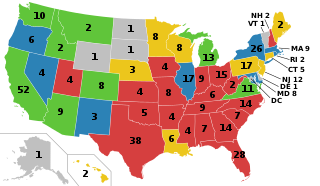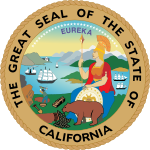
The Voting Rights Act of 1965 is a landmark piece of federal legislation in the United States that prohibits racial discrimination in voting. It was signed into law by President Lyndon B. Johnson during the height of the civil rights movement on August 6, 1965, and Congress later amended the Act five times to expand its protections. Designed to enforce the voting rights protected by the Fourteenth and Fifteenth Amendments to the United States Constitution, the Act sought to secure the right to vote for racial minorities throughout the country, especially in the South. According to the U.S. Department of Justice, the Act is considered to be the most effective piece of federal civil rights legislation ever enacted in the country. The National Archives and Records Administration stated: "The Voting Rights Act of 1965 was the most significant statutory change in the relationship between the federal and state governments in the area of voting since the Reconstruction period following the Civil War".

The NAACP Legal Defense and Educational Fund, Inc. is an American civil rights organization and law firm based in New York City.

FairVote, formerly the Center for Voting and Democracy, is a 501(c)(3) organization that advocates electoral reform in the United States.
Gomillion v. Lightfoot, 364 U.S. 339 (1960), was a landmark decision of the Supreme Court of the United States that found an electoral district with boundaries created to disenfranchise African Americans violated the Fifteenth Amendment.

Shaw v. Reno, 509 U.S. 630 (1993), was a landmark United States Supreme Court case in the area of redistricting and racial gerrymandering. After the 1990 census, North Carolina qualified to have a 12th district and drew it in a distinct snake-like manner in order to create a "majority-minority" Black district. From there, Ruth O. Shaw sued to challenge this proposed plan with the argument that this 12th district was unconstitutional and violated the Fourteenth Amendment under the clause of equal protection. In contrast, Reno, the Attorney General, argued that the district would allow for minority groups to have a voice in elections. In the decision, the court ruled in a 5–4 majority that redistricting based on race must be held to a standard of strict scrutiny under the equal protection clause and on the basis that it violated the Fourteenth Amendment because it was drawn solely based on race.
Nativo Lopez-Vigil was an American political leader and immigrant rights activist in Southern California. Lopez was a national president of the Mexican American Political Association and the national director of the Hermandad Mexicana Latinoamericana, a community service and advocacy organization for Mexican and Latin American immigrants throughout the United States.
League of United Latin American Citizens v. Perry, 548 U.S. 399 (2006), is a Supreme Court of the United States case in which the Court ruled that only District 23 of the 2003 Texas redistricting violated the Voting Rights Act. The Court refused to throw out the entire plan, ruling that the plaintiffs failed to state a sufficient claim of partisan gerrymandering.
The Chicago Lawyers' Committee for Civil Rights is a consortium of American law firms in Chicago that provides legal services in civil rights cases
Madera Unified School District is a public school district serving Madera, California.
Thornburg v. Gingles, 478 U.S. 30 (1986), was a United States Supreme Court case in which a unanimous Court found that "the legacy of official discrimination ... acted in concert with the multimember districting scheme to impair the ability of "cohesive groups of black voters to participate equally in the political process and to elect candidates of their choice." The ruling resulted in the invalidation of districts in the North Carolina General Assembly and led to more single-member districts in state legislatures.
Shelby County v. Holder, 570 U.S. 529 (2013), was a landmark decision of the Supreme Court of the United States regarding the constitutionality of two provisions of the Voting Rights Act of 1965: Section 5, which requires certain states and local governments to obtain federal preclearance before implementing any changes to their voting laws or practices; and subsection (b) of Section 4, which contains the coverage formula that determines which jurisdictions are subject to preclearance based on their histories of racial discrimination in voting.

Gerrymandering is the practice of setting boundaries of electoral districts to favor specific political interests within legislative bodies, often resulting in districts with convoluted, winding boundaries rather than compact areas. The term "gerrymandering" was coined after a review of Massachusetts's redistricting maps of 1812 set by Governor Elbridge Gerry noted that one of the districts looked like a mythical salamander.

Bernette Joshua Johnson is an American lawyer from New Orleans, who served as the chief justice of the Louisiana Supreme Court from 2013 to 2020.
Edward Jay Blum is an American conservative litigant who opposes diversity programs such as affirmative action based on race and ethnicity.
Joaquin Guadalupe Avila was an American voting rights attorney and activist. Avila spent more than two decades using the federal Voting Rights Act of 1965 to increase election fairness for minority voters. But as several court precedents weakened the federal Voting Rights Act, Avila conceived of state voting rights acts as a way to again strengthen minority voting rights. Thus Avila crafted the California Voting Rights Act that was enacted in 2001.
Abbott v. Perez, 585 U.S. ___ (2018), was a United States Supreme Court case dealing with the redistricting of the state of Texas following the 2010 census.
Virginia House of Delegates v. Bethune-Hill, 587 U.S. ___ (2019), was a case argued before the United States Supreme Court on March 18, 2019, in which the Virginia House of Delegates appealed against the decision in 2018 by the district court that 11 of Virginia's voting districts were racially gerrymandered, and thus unconstitutional. The Court held the "Virginia House of Delegates lacks standing to file this appeal, either representing the state's interests or in its own right." In other words, the court upheld the decision made by a federal district court ruling in June 2018 that 11 state legislative districts were an illegal racial gerrymander. This was following a previous (2017) case, Bethune-Hill v. Virginia State Bd. of Elections.

The Virginia Beach City Council is the legislative branch that governs the City of Virginia Beach and its more than 450,000 citizens. It has 11 members that serve four-year terms and are elected on a staggered basis. General elections are held the Tuesday following the first Monday in November in even-numbered years. All registered voters are eligible to vote for all members of City Council. Three Council Members and the Mayor serve "At Large" with no district residency requirement. All other Council Members are required to live in the districts they represent: Bayside, Beach, Centerville, Kempsville, Lynnhaven, Princess Anne, and Rose Hall. The Council holds regular meetings on alternate Tuesday evenings on the second floor of the Virginia Beach City Hall.
Brnovich v. Democratic National Committee, 594 U.S. ___ (2021), was a United States Supreme Court case related to voting rights established by the Voting Rights Act of 1965 (VRA), and specifically the applicability of Section 2's general provision barring discrimination against minorities in state and local election laws in the wake of the 2013 Supreme Court decision Shelby County v. Holder, which removed the preclearance requirements for election laws for certain states that had been set by Sections 4(b) and 5. Brnovich v. Democratic National Committee involves two of Arizona's election policies: one outlawing ballot collection and another banning out-of-precinct voting. The Supreme Court ruled in a 6–3 decision in July 2021 that neither of Arizona's election policies violated the VRA or had a racially discriminatory purpose.
Allen v. Milligan, 599 U. S. 1 (2023), is a United States Supreme Court case related to redistricting under the Voting Rights Act of 1965 (VRA). The appellees and respondants argued that Alabama's congressional districts discriminated against African-American voters. The Court ruled 5–4 that Alabama’s districts likely violated the VRA, maintained an injunction that required Alabama to create an additional majority-minority district, and held that Section 2 of the VRA is constitutional in the redistricting context.









